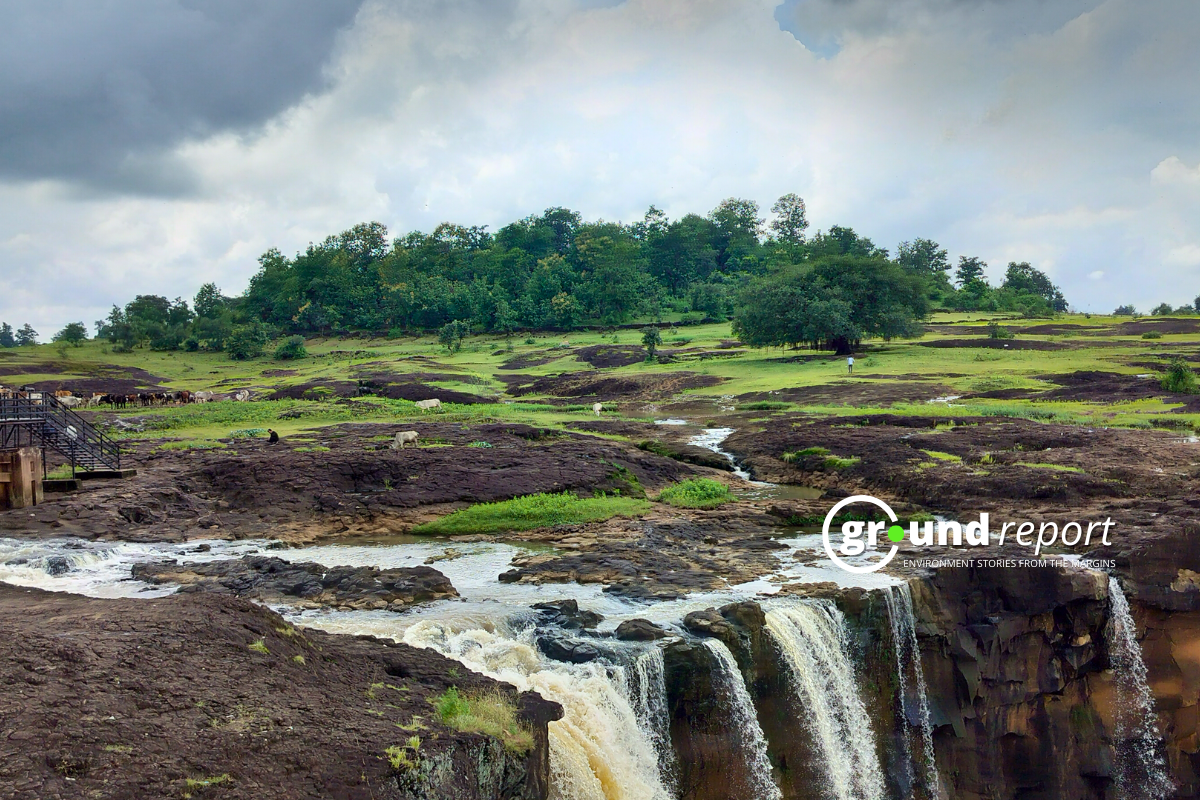“I have been making donna pattal since the age of 10, a skill passed down to me by my mother,” recalls Gangabai, a resident of Pandoda village in Madhya Pradesh’s Budhni block. In her small community, nestled beside a constantly busy road, she is affectionately known as the “Amma (mother) who makes Dona Pattal.” Now 55 years old, she lives in a mud house with her daughter-in-law.
The history of Donna Pattal—traditional leaf cutlery—dates back centuries, if not longer. These disposable plates and bowls, made from dried leaves, have been widely used across India, Bangladesh, Nepal, and Sri Lanka for serving food at religious ceremonies, weddings, and community feasts. Biodegradable and eco-friendly, they have been integral to the Indian subcontinent’s culture for generations but have gradually faded with changing times.
“Traditionally, donna pattal was commonly used at weddings and public feasts,” Gangabai recalls.
Donna (bowls) and pattal (plates) are made from large, round wild forest leaves. Gangabai stitches together the leaves to make her cutlery. The palash tree (Butea monosperma)—also known as Dhak, Tesu, or locally as Khakra—produces large, circular leaves ideal for this purpose. Donna pattal represents a sustainable alternative, but it is increasingly being replaced by thermocol or plastic alternatives.

Plastic disposables market
The Indian disposable plate market is projected to reach USD 5,472.5 million by 2025 and grow 3.6% annually to USD 7,759.3 million by 2035. This growth spans street food vendors to premium takeout services, fuelled further by cloud kitchens and food delivery apps. Interestingly, the market data reveals that plastic commands 58–60% of India’s disposable market, with paper and thermocol products comprising the remainder.
“When disposable plates and cups made of plastic and paper weren’t available, our business flourished,” Gangabai explains. “There was a demand for our donna pattal.”
Some of these plastic products are made from recycled plastics, which experts warn can have toxic chemicals. Despite environmental concerns prompting calls for sustainable alternatives, plastic continues its market dominance.
Art of palash leaf plates

Gangabai has formed a small collective of four to five women in the village, including 45-year-old Shanti Devi. Gangabai in her unusual gait, with most of her weight on the hips, takes us to meet Shanti Devi. The concrete road was choked with sewage water and cattle dung. With slippers, Gangabai swiftly reaches in front of Shanti Devi’s home. She is outside the house, with other women.
These women do everything, from collecting the resources to finding the client. The beauty of these leaf plates and bowls lies in the intricate leaf stitching. The stitching is almost the end process of the supply chain. Shanti-Devi says, “We travel 16 kilometers to the Yarnagar forests to collect leaves, crossing a hill.” The availability of leaves also fluctuates. With changing times, palaash trees with voluminous leaves are becoming harder to find. The women collectively share that they venture deep into the forest to gather enough leaves. They quickly point to the surrounding agricultural land as the cause—forest areas are being cleared for cultivation. “Earlier, khakra leaves were available near our homes,” Gangabai explains. As urbanization accelerated with the construction of houses, buildings, and roads, khakra trees were cut. Getting leaves has become increasingly laborious.”

A 2018 study by the Uttarakhand Forest Research Centre identified premature flowering in Palash trees as an existential threat. As per the study, this premature flowering between 2015 and 2017 showed a diminished ability to produce viable seeds, jeopardising natural regeneration. However, the recent data shows some positive trends. The State of Forest Report 2023 indicates the volume of Butea monosperma growing outside forest areas increased from 43.96 million cubic meters in 2021 to 48.79 million cubic meters in 2023. Agroforestry initiatives have boosted Butea monosperma plantings by 82.89 percent nationwide over three years.
“We regularly encounter wild animals, snakes, and scorpions,” Devi explains. What do they do when they hear a wild animal nearby? “What else? We run, leaving all the leaves behind,” she says. Recently, they spotted fresh tiger paw prints in the forest. However, the dangers extend beyond wild animals. “A few days ago, we came across a group of intoxicated young men, around 25 to 30 years old, in the forest,” Shanti recalls. “We fear them more than wild animals—they harass us.”

Shanti acknowledges family pressure: “Our families tell us to stay out of the forests, but we need to earn a living.” Gangabai and Shanti Devi depend on forest resources for their work. And the restrictions to access the forest create additional hardships. “We previously collected leaves from Salkanpur forest, but it’s now fenced off,” Gangabai notes. Shanti adds, “If we go into any forest besides Yarnagar, rangers berate us, drive us away, and threaten us.” These challenges, combined with generational disinterest, threaten the skill’s survival. “After us, this practice will disappear,” Gangabai laments.
“The younger generation lacks the courage to risk forest expeditions.”
Once they are back home. The leaves are dried out in the sun. Then, these women meticulously stitch palash leaves, with dexterity, together to form round plates and bowls. The work is divided between five women, under Gangabai’s guidance. But how much do they earn for their labor? For the entire process—collecting leaves from the forest, crafting the plates at home, and ensuring timely delivery—the women earn only one rupee per pattal. Donas are sold at an even lower price. “We can’t negotiate… we take what we get,” Gangabai says when I point out the unfairness of these rates. She adds that if the shopkeeper fails to sell the stock, they sometimes return the order.

Despite challenges, the women persist. “Finding employment nowadays is challenging. This work helps us survive,” Shanti notes. Gangabai has grown old. She walks with an unusual gait and sits on the chair with great effort. She worked at the nearby textile factory, earning ₹170 daily. “Factory labour is beyond my capabilities now,” she explains.
Palash trees and factors that threaten it
Their small business operates year-round, with a brief pause between February and March when Palash trees shed their leaves and begin flowering. Poets have long been captivated by the fiery orange-red blossoms of the palash tree, often calling it the “fire of the forest” for its dramatic transformation. By the end of February, its leaves had completely shed, giving way to brilliant yellow and crimson flowers.

Beyond its leaves, which are used for dona pattal, the Palash tree is quite resourceful. The flowers produce natural Holi colors, while the lac deposits on its branches—sold for ₹300-400 per kilogram—are valued in medicine and jewelry making. These materials serve as an important source of income for tribal communities. Palash grows throughout India, from plains to mountains, thriving even in arid regions. One of three dominant tree species in Madhya Pradesh’s forests, earning it the status of the state flower.
These skilled artisans continue residing in mud houses; their applications for PM Aawas are stalled in bureaucratic processes. Shanti Devi says,
“If the government wants to help us, they should provide us a house under PM Awas Yojana; we are waiting for our pucca house for many years.”
As plastic pollution escalates globally, sustainable and biodegradable alternatives become increasingly critical. Reviving traditional practices like dona pattal production for public events would deliver dual benefits—environmental protection and economic empowerment for artisans like Gangabai and Shanti Devi.
By supporting these traditional crafts, India can address plastic pollution while preserving cultural heritage and providing dignified livelihoods for rural communities—a harmonious balance between tradition, economic justice, and environmental stewardship.
Support us to keep independent environmental journalism alive in India.
Keep Reading
Erratic rainfall: Orange farmers and traders suffer in Pandhurna
Wadda Mal’s water woes: Families fight for survival amid crisis
Chhindwara’s maize-ethanol dream: promise vs reality
Soil Health Card: Ambitious scheme faces ground-level challenges
Follow Ground Report on X, Instagram and Facebook for environmental and underreported stories from the margins. Give us feedback on our email id greport2018@gmail.com.
Don’t forget to Subscribe to our weekly newsletter, Join our community on WhatsApp, and Follow our YouTube Channel for video stories







